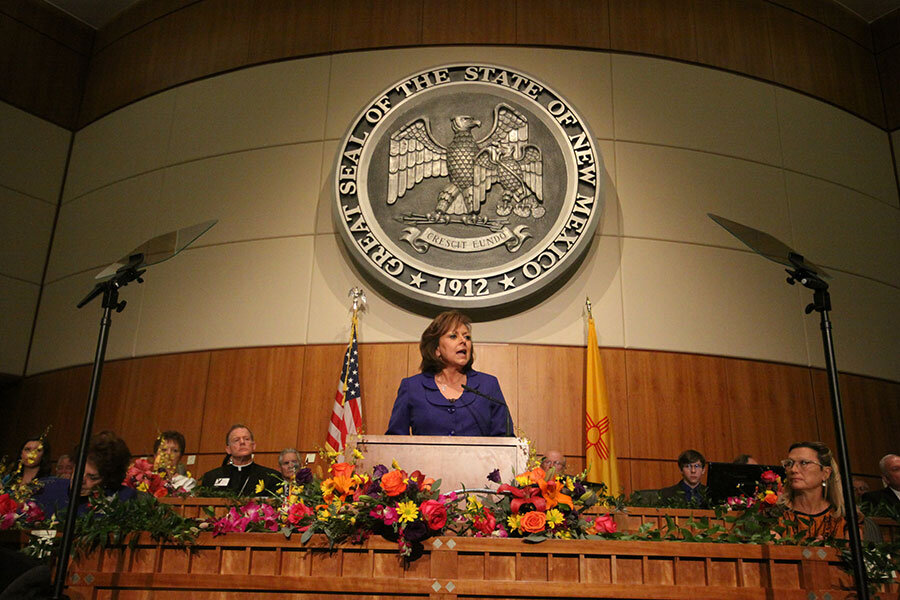One state's push to return to get-tough-on-crime 1990s
Loading...
New Mexico Gov. Susana Martinez’s recent speech was not your typical State of the State address.
At a time when lawmakers of both parties nationwide are finding unusual agreement over the need to reform the criminal justice system, Governor Martinez’s address sounded like something out of the get-tough-on-crime 1990s.
She called for broadening the state’s "three-strikes" law and barring judges from deferring small parts of mandatory minimum sentences in some cases.
While the nation as a whole remains in a period of historically low violent crime rates, New Mexico was ranked as the second most-dangerous state in the country in a 2015 survey. More recently, it has seen a rash of high-profile cases.
What’s happening there hints at how fragile the current push for reform nationwide could be. When violent crime spikes, the get-tough-on-crime talk returns.
To be sure, New Mexico faces challenges. Its violent crime rate jumped 6.6 percent from 2012 to 2013 – the highest increase in the country, according to the 2015 study by 24/7 Wall St.
But experts suggest that state’s violent crime rate is well below 1990s levels and the crimes in a few locations are creating anxieties disproportionate to the actual danger.
But the perception is what can matter most in politics.
"The legislators are reacting to certain things that might be happening in their communities, but if we're talking about this historically we're talking about very, very decreased crime rates since the 1990s," says Lauren-Brooke Eisen, a senior counsel for the Brennan Center for Justice in New York. "There may be pockets of crime in certain jurisdictions, but it's important to not have a knee-jerk reaction."
Martinez, who was elected on a get-tough-on-crime platform, highlighted a few specific events in her State of the State address – including the shooting deaths of two police officers.
"We have vicious, heinous criminals among us who are willing to take the lives of our greatest heroes and who have no business being out on our streets," she said, according to the New Mexico Political Report. "We need laws that are tough in substance, not just in sound bites."
The bid to broaden the state’s "three-strikes" law – which imposes life sentences on people who break the same law three times – was also tied to a recent high-profile case. The bill has the support of the mother of 4-year-old Lilly Garcia, who was shot and killed in a road-rage incident last October.
Among her other proposals are changes to allow judges to deny bail to high-risk subjects, to bar them from suspending or deferring more than 15 percent of a mandatory minimum sentence for a number of charges, and making attacks on police punishable by hate crimes laws.
Some of the bills face opposition from Democratic lawmakers, particularly in the state Senate, where they hold a majority and have stopped similar bills in recent years.
"Put money in drug and alcohol rehabilitation throughout the state… let's get serious about it," said Michael Sanchez, the state Senate majority leader, KRQE News reported. “Wanna talk tough? Let’s talk tough. We have too many people who need help and they're being ignored, they're in the shadows.”
Other states and even Congress have moved conspicuously away from the sorts of proposals made by Martinez.
In 2014, for example, California relaxed its three-strikes law that was partly blamed for prison overcrowding in the state. US lawmakers are considering relaxing the federal three-strikes law regarding life sentences for three drug-related crimes.
There is also bipartisan support in Congress for laws easing mandatory minimum sentences for nonviolent, drug-related crimes.
In New Mexico, crime has decreased by 38 percent since 1990, according to Ms. Eisen of the Brennan Center for Justice. Yet the figures from 2013 and 2014 create a distorted public perception of the state's crime problem, she adds.
Gabriel Sanchez, a political scientist at the University of New Mexico, agrees that public sentiment has been driven in particular by rare but high-profile cases.
"The governor is really trying to capitalize on public sentiment that there has to be something done about crime," he says.
Still, he thinks it's unlikely much of the legislation will pass in this session, which is only 30 days long and is meant to focus on budget issues. Senate Democrats in particular, he says, "can pretty much kill any [bill] that comes up" for a vote.
The issues could feature prominently in elections this November, where all 112 seats in the legislature will be contested, however, and it could return in the next legislative session next year, he says.
The key is helping voters see past the shock of an individual crime to the actual facts, says Nancy Fishman, project director for the Center on Sentencing and Corrections at the Vera Institute for Justice, in an e-mail.
“The public tends to pay more attention to criminal justice policies when crime rates rise or they believe crime rates have risen, and may then be more responsive to ‘tough on crime’ stances,” she writes. “They could just as easily respond well to informed, strategic responses targeted to address particular public safety challenges if those responses were voiced and explained by policymakers.”






